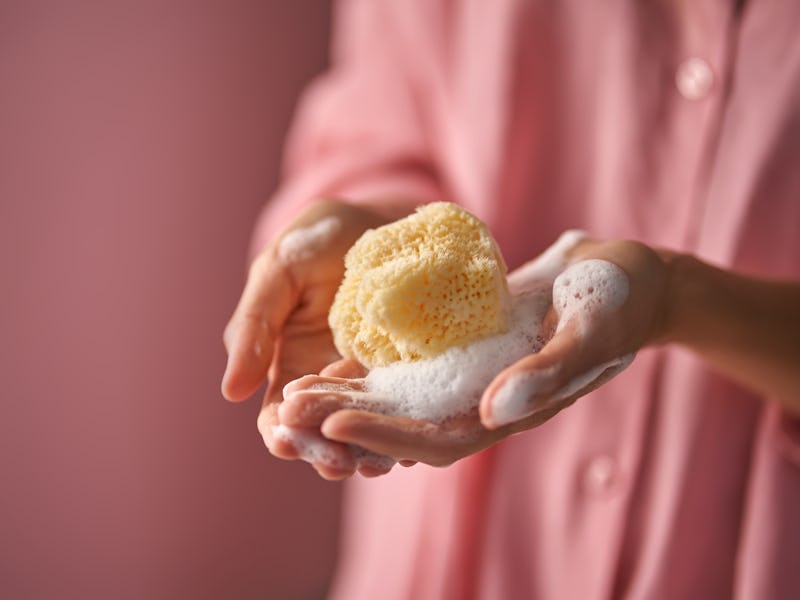A New Loofah-inspired Device Purifies Water Using the Power of the Sun
It could offer a quick, low-cost solution for the billions of people around the world living without clean drinking water.

Water is key to survival — it’s essential to prepare meals, bathe, clean clothing, and, of course, stay hydrated. But much of the world lacks reliable access to clean, fresh H2O.
That’s why scientists recently developed a gel that could purify water quickly and sustainably at a low cost. To achieve this, a team of engineers had to tinker with the hydrogel’s structure, drawing inspiration from a common object in many showers: loofahs.
“For materials, changing the structure is the difficult part,” Xiaohui Xu, a chemical engineer at Princeton University and co-author of the new study, tells Inverse. Best of all, the gel runs on the sun’s bountiful rays, according to a new study published in the journal ACS Central Science.
A porous hydrogel inspired by loofahs, shown here, could purify water quickly and cheaply.
Water disparities
Roughly a third of the world’s population lacks access to clean, fresh water, according to the World Health Organization. And around a quarter of people also go without clean water for bathing, washing, and other sanitation practices.
As climate change dries out formerly lush regions and pollution and industrial waste products contaminate more bodies of fresh water, these disparities could increase.
Technically, people can drink contaminated fresh water, but without proper sanitation the risks are myriad. Waterborne diseases such as cholera, giardia, and dysentery can cause severe fever and diarrhea — in many cases, they can be lethal. Outbreaks of these illnesses kill 7,000 people each year in the US alone. Globally, that number is estimated at 829,000.
To prevent the majority of those deaths, scientists and public policymakers are seeking energy-efficient and inexpensive solutions that can clean fresh water effectively.
A life-saving “loofah”
These dried cucumber relatives are often used for shower scrubbing — their unique structure inspired scientists to create a cost-effective water purifying device.
That’s where the new hydrogel may come in. It could purify water using nothing more than sunlight. Its design takes inspiration from a loofah, a dried, fibrous gourd that doubles as a popular bath exfoliator.
Thanks to its open-pore structure, a loofah can absorb large quantities of water very quickly. This is a distinct advantage over other absorbent materials, like a sponge (it absorbs and releases water far more slowly). “We were thinking right away that we wanted to avoid this process,” Xu says.
The researchers configured their hydrogel to mimic the loofah’s super-absorbent structure, allowing the gel to quickly filter out large contaminants as water flows in — but they built in an extra twist.
The hydrogel is made from a polymer known as poly(N-isopropylacrylamide), or PNIPAm. This material is heat sensitive — when it’s heated to 91 degrees Fahrenheit, it switches from a hydrophilic (water-loving) to a hydrophobic (water-repelling) state. When this happens, the gel expels most of the water in less than five minutes.
During this process, tiny contaminants within the liquid, such as chemical dyes and microplastics, get trapped in the material’s polymer matrix.
This means that the hydrogel has double filtration power: it can filter large particles while also stopping small particles in their tracks.
What’s next
The researchers hope that their material will offer a simple, energy-efficient way to purify water in regions of the world that don’t have the infrastructure to easily sanitize large amounts of fresh water for drinking.
Initially, they envision a small version for individual homes. But eventually, they would like to see it used at the industrial level. “We want to think large-scale,” says Xu.
While the gel excels at filtering and trapping contaminants, the researchers would also like to improve on its capabilities — ideally by imbuing it with the power to degrade harmful molecules such as those in dyes.
Eventually, they even want to develop a version that can filter salt out of seawater — a helpful option for people living on coasts surrounded by miles of potential drinking water. For Xu, part of the appeal of her team’s new hydrogel is its potential to do good in the world. “It’s quite exciting,” she says.